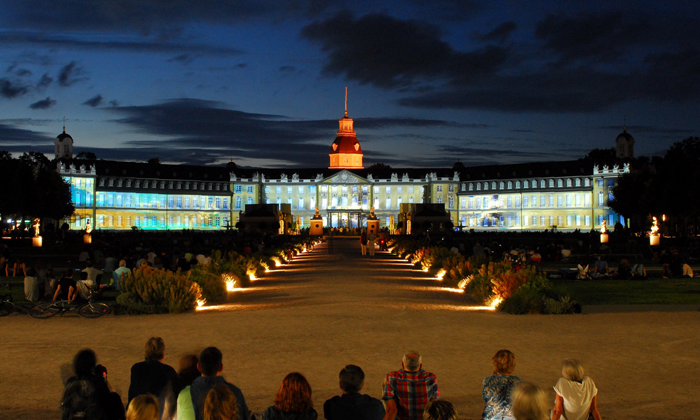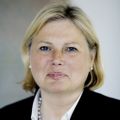Karlsruhe’s integrated approach to transport
- Like
- Digg
- Del
- Tumblr
- VKontakte
- Buffer
- Love This
- Odnoklassniki
- Meneame
- Blogger
- Amazon
- Yahoo Mail
- Gmail
- AOL
- Newsvine
- HackerNews
- Evernote
- MySpace
- Mail.ru
- Viadeo
- Line
- Comments
- Yummly
- SMS
- Viber
- Telegram
- Subscribe
- Skype
- Facebook Messenger
- Kakao
- LiveJournal
- Yammer
- Edgar
- Fintel
- Mix
- Instapaper
- Copy Link
Posted: 14 June 2018 | Prof. Dr.-Ing. Anke Karmann-Woessner | No comments yet
By 2015, Karlsruhe had 315,000 residents, trending upwards. In a city characterised by a combination of innovative, knowledge-based organisations, low unemployment and expanding companies, Prof. Dr.-Ing. Anke Karmann-Woessner, Head of the City of Karlsruhe’s Urban Planning Department, explains how an intermodal transport system and its users are at the heart of urban development in the city.


THANKS to progressive digitalisation, new technical developments and changes in behaviour, our mobility is changing at a breathtaking pace, and there are still huge leaps of innovation yet to happen in the coming years. There is a strong foundation in Karlsruhe for future-oriented technologies and a range of excellent academic and research institutions, well connected with local and regional businesses – like the ZKM (Center for Art and Media), a unique cultural institution worldwide.
Importantly, many citizens, specifically younger generations, now believe that being able to use a car is more important than owning a car. Karlsruhe is one of the cities in which the number of car-free households is increasing and instead, alternatives like car-sharing are being used.
Solutions for urban mobility are particularly urgent. In Karlsruhe, with its specific climate by the Rhine, the delicate landscape and its biodiversity requires protection, highlighting the need to develop innovative mobility strategies from an early stage. However, it is difficult in everyday life to consistently implement these goals, especially when unpopular goals must be set. Transport planning projects are long-term decisions; legislative periods are much shorter. That is why it is important to monitor the agreed policy measures every two to three years.
Appropriate methods that suit changing lifestyles must be used when approaching urban mobility solutions. Intermodality is a crucial factor and Karlsruhe has chosen an integrated approach based on fundamental political decisions that go beyond a technical traffic solution.
Karlsruhe’s consistent intermodal transport policy
The future challenge lies in achieving a broader understanding of urban mobility: urban planning and mobility development must be seen as two sides of the same coin, with transport and mobility as variables dependent on settlement structures and land use. A strong connection between environmental quality and mobility must exist, as it is the only effective way to reach the agreed limits for climate and noise protection.
Mobility must be considered a technical as well as a social task, with a focus on people’s requirements concerning the mobility plan.
Connecting the various modes of transport within an overall system, and emphasising their respective strengths, is considered in:
- The sustainable urban mobility plan Karlsruhe (SUMP 2012), supported by the smart mobility solution RegioMOVE
- The Kombilösung
- The Spatial Agenda Karlsruhe (2016).
Sustainable urban mobility plan Karlsruhe (SUMP 2012)
The Karlsruhe SUMP is one of the strategies within the Urban Development Concept 2020 and illustrates the city’s objectives for developing and implementing sustainable mobility in the next 10-15 years. It is a framework for the development of Karlsruhe’s mobility system and includes all traffic modes, taking the urban structure and settlement development into account, and considering environmental and urban compatibility. It ensures equal mobility opportunities for all population groups.
SUMP sets out objectives and specifies implementation measures for basic networks, pedestrian and cycling infrastructure, public transport and private motorised transport. The draft was designed as a process and the content of each module created by engaging with city committees, administration specialists and relevant stakeholders. These objectives include:
- Promoting sustainable and low-emission mobility with practical approaches to avoid urban traffic, considering the changing behavioural patterns of road users and raising consumer awareness
- Further developing strategies across all transport modes for smart mobility, focusing on more economical modes of transport (public transport network, cycling, walking) by implementing new technologies and networked information in view of the digital transformation
- Promoting modern, digitalised mobility including urban neighbourhoods
- Developing intermodal and multimodal mobility concepts for passengers and goods supported by an appropriate digital infrastructure.
SUMP contains not only strategic objectives, but also 120 concrete projects adopted by the city council on: urban planning principle – ‘city of short distances’; 20-points-programme for bicycle traffic; extension of public transport; transport management; public relations; and multimodal mobility.
Smart mobility solution RegioMOVE
Over the next few years, the Karlsruhe Transport Association (KVV) will evolve from a traditional transport association into a mobility association.
In order to strengthen intermodal mobility in the region, the various offers within the RegioMOVE framework will see many transport companies networking with each other in the coming years. Alongside bus and train connections, car-sharing and cycle-hire operators will be integrated into the system. The aim is to have several mobility providers together on a common platform, meaning that at selected hubs in the future, passengers will be able to easily choose and change between different means of transport. The programme is funded by the State of Baden-Württemberg and the European Regional Development Fund (ERDF).
The Kombilösung
In order to encourage users of motorised private transport to switch to local public transport, the offering needs to become more attractive. In addition to speed and price, comfort and ease of use play particularly important roles in the choice of transport.
Karlsruhe’s main railway station and city centre are up to 3km apart. In the 1980s and 1990s, roads and railway lines were linked to eliminate the break between S-Bahn/regional traffic and tram and city bus traffic. The new light rail system was guided through the pedestrian areas of the city centre to connect the city and surrounding countryside that lacked changeovers. The vehicles, equipped for both systems, travel from the surrounding area to Karlsruhe, in which they cross as a tram and then serve the surrounding area again as an urban or regional train – the Karlsruhe model.
The increasing demand in the city centre of Karlsruhe led to considerable conflicts in public space, especially with pedestrian traffic, but also reduced the efficiency of public transport.
The route between Europaplatz and Kronenplatz can be transformed into a pedestrian zone by running underground. In addition to the approximately 2.4km west-east tunnel, a 900m north to south tunnel will be built. Seven new underground stops and seven above-ground stops will improve access, alongside four direct access points to inner-city shopping centres.
In parallel, a tram line between bike paths and tree-lined alleys is being constructed along Kriegsstraße. Automobile traffic will run underground through a vehicle tunnel from Karlstor to Mendelssohnplatz. These two projects together are referred to as the Kombilösung, an important precondition for intermodal transport solutions.
Spatial Agenda Karlsruhe (2016)
Mobility patterns always depend on settlement layout and land use. The only way to work effectively is to forge a strong connection between urban development, mobility and environmental quality.
Developing these areas presents both opportunities and challenges. Creating something new presents the possibility of improving the old, meaning the regeneration of older neighbourhoods and enhancement of existing districts.
We aim to restrain Karlsruhe’s growth to areas within the district outline, so that the surrounding landscape is dedicated to recreation, agriculture, forestry and nature conservation. Karlsruhe’s potential lies in the inner city and is set to be developed to a high standard.
Karlsruhe is one of Germany’s mobility capitals. Few other cities offer as many interconnected transport options and this asset must be further developed. Karlsruhe is exploring new avenues with access and connectivity setting new standards for the quality of life and providing new inputs for neighbourhood development.
The development of transport systems, and the city, is measured in terms of accessibility – light-rail and trams stops being linked to footpaths, cycle lanes and car-sharing. The design of transport nodes can help to foster exchanges and meetings.
Karlsruhe’s railway stations are key to its transport plan, offering access to national and regional transport. But it is the interchanges they provide with the city’s transport networks that makes them starting points for urban transport integration. Reinforcing their role as mobility points helps railway stations drive transport behaviour and development. Additional transport offers, innovative information technology and attractive design reinforce their driving role for sustainable transport. Railway stations thereby help develop attractive places to live and work.
Karlsruhe’s transport development plan is dedicated to promoting sustainable transport modes. Coinciding with railway stations helps the already established high levels of public transport provision, along with alternative modes, unfold to their full potential as mobility points. This requires stations to evolve into places to stay, to meet and to change between transport modes. Their evolution can – and should – drive surrounding urban development.
Together, these challenges present the city with new issues requiring specific answers.
The vast range of life situations and relevant cultural and economic contexts present a very particular and exciting challenge. Finally, ‘soft’ factors lead to very different transport preferences: ’swing users’ select their own combination of mobility modes, making changes according to their individual lives. By strengthening local public transport – the decisive prerequisite for an effective intermodal transport concept – the political community has made a clear commitment to sustainable transport planning.
We plan with the best of intentions, but ultimately, as Steve Jobs said in 1994: “What’s important is that you have a faith in people, that they’re basically good and smart, and if you give them tools, they’ll do wonderful things with them. It’s not the tools that you have faith in… it’s people you have faith in or not.”
Biography


Related topics
Multimodality, Sustainable Urban Transport
Issue
Issue 2 2018
Related organisations
City of Karlsruhe’s Urban Planning Department
Related people
Prof. Dr.-Ing. Anke Karmann-Woessner








